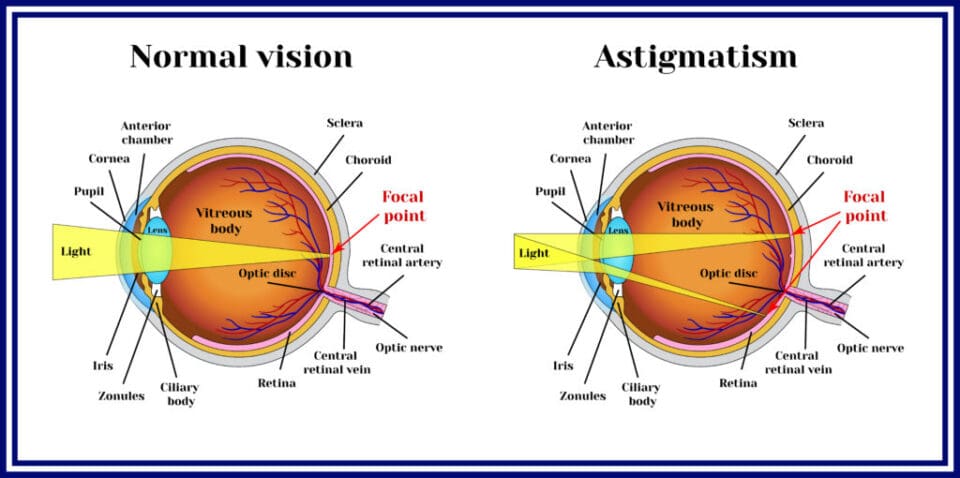
Medically Reviewed by Tom Tooma, M.D., Founder/Medical Director
LASIK for Astigmatism: Success Rates, Costs, Recovery & FAQs
Home /
Last Updated:

Medically Reviewed by Tom Tooma, M.D., Founder/Medical Director

Article At a Glance
LASIK effectively treats astigmatism by reshaping the cornea into a more regular form, improving how light focuses on the retina. The procedure is quick, with most patients experiencing minimal discomfort and rapid recovery. Many achieve 20/20 vision or better, reducing or eliminating the need for corrective lenses.
LASIK eye surgery can help with the most common kind of astigmatism, corneal astigmatism, within a certain range of refractive error.
For eligible candidates, it can provide a dramatic improvement in visual acuity and offers a convenient option for astigmatism treatment. Many LASIK treatment centers offer reasonable pricing and payment plans, making it an affordable choice to treat astigmatism.
Table of Contents
What is Astigmatism?
Astigmatism is a type of refractive error, a category of conditions in which light imperfectly refracts in the eye, causing blurriness in a person’s vision. This usually occurs because your cornea or lens is oddly shaped — more oval-like than round.
There are two types of astigmatism:
You deserve clear vision. We can help.
With 135+ locations and over 2.5 million procedures performed, our board-certified eye surgeons deliver results you can trust. Your journey to better vision starts here.
- Corneal astigmatism: The cornea has a distorted shape, causing the refractive error.
- Lenticular astigmatism: The eye’s lens is misshapen, causing the refractive error.
It’s not known what causes astigmatism, and there’s no way to prevent this vision problem.
What Does LASIK Do for Astigmatism?
LASIK surgery works by surgically altering the shape of your cornea with a laser, so light can better refract and land on your retina. The retina is a key part of the eye that takes in light and sends the appropriate visual signals to your brain for clear and accurate vision.
LASIK addresses astigmatism by correcting the shape of the cornea to make it more round, so that it can better process and reflect light signals to the retina – thus greatly improving vision.
Because of the way LASIK works — by changing the cornea with a laser — it cannot correct lenticular astigmatism, which is caused by a lens issue and not a cornea problem. Lenticular astigmatism is less common than corneal astigmatism.

Who Is a Candidate for LASIK Astigmatism?
To qualify for LASIK for astigmatism, it must be determined that you have corneal astigmatism rather than lenticular astigmatism. Corneal astigmatism is the more common form of the condition.
You then need to meet the standard criteria for LASIK. These are some factors that may make you ineligible for LASIK:
- Unstable vision, with your prescription frequently changing
- An autoimmune condition that increases your risk of surgical complications, including rheumatoid arthritis and HIV
- Thin corneas or otherwise weakened eyes, which can increase your risk of structural failure during surgery
- Under the age of 18
These are other possible risk factors that may eliminate LASIK as a treatment option for your astigmatism:
- Diabetes
- Severe hypertension (high blood pressure), which can result in hypertensive retinopathy
- Use of certain medications, including immunosuppressive medications
- Eye disease that causes deterioration of vision
- Infection disorder that affects the eye, such as herpes simplex on the eye
- Inflammation disorder of the eye, such as keratitis or uveitis
- Chronically dry eyes
- Active participation in contact sports that may result in injury or trauma to the eye
- Glaucoma
- Unusually large pupils
- Cataracts
Key Facts About LASIK for Astigmatism
- LASIK is used to treat corneal astigmatism but not lenticular astigmatism.
- Corneal astigmatism is caused by an irregularly shaped cornea. LASIK works by using a laser to reshape the cornea, so it properly reflects and processes light and visual signals. This dramatically improves vision.
- Serious complications from LASIK are very rare, occurring in less than 1 percent of cases.
- After surgery, over 98 percent of patients feel they achieved their goal with LASIK.
- Postoperative symptoms, such as dry eye, are most common in the period immediately following LASIK. Most symptoms resolve within three to six months.
What to Expect With LASIK for Astigmatism
LASIK for astigmatism is the same procedure as general LASIK. The surgeon will map the topography of your cornea, determining how much to cut away to correct refractive errors, including your astigmatism.
During the procedure, your surgeon will cut a flap in your cornea in order to reshape the cornea below. Ultra-thin layers of your cornea are removed to correct your astigmatism along with any nearsightedness or farsightedness you have. After the cornea is reshaped, the flap is put back in place.
The tissue that is removed does not grow back, so the changes made will stay with you for the rest of your life.

You deserve clear vision. We can help.
With 135+ locations and over 2.5 million procedures performed, our board-certified eye surgeons deliver results you can trust. Your journey to better vision starts here.
Success Rates of LASIK
LASIK surgery has a very high patient satisfaction rate, which is significant. It is widely considered safe by both the FDA and relevant experts in the field.
The long-term results of LASIK are also impressive. In two 2016 studies, patients were reporting continued improved vision five years after treatment, with over 94 percent needing no corrective lenses and less than 2 percent requiring retreatment.
Costs of LASIK Surgery for Astigmatism
LASIK usually costs between $1,500 and $3,000 per eye.
LASIK is considered an elective treatment by insurance providers, meaning they often won’t cover the costs. Many vision insurance plans offer discount programs to offset the cost of LASIK under certain conditions.

Financing Your LASIK Procedure
We believe every patient should have access to the life changing procedures NVISION® offers. Since LASIK is considered an elective medical procedure or advantageous to the patient but not urgent, it is typically not covered under insurance plans. Our financing options ensure that you are not held back by cost. Read on to learn more about CareCredit®, FSA/HSA, Insurance Discounts and other options.
Recovery After Astigmatism Correction With LASIK

The aftercare recommendations for LASIK are the same regardless of the type of refractive error you had corrected. If you have LASIK to correct astigmatism, you can promote the healing process by following your surgeon’s aftercare instructions closely.
While most people return to most normal activities within a day or two of LASIK, full recovery usually takes between three and six months. At that point, a patient has generally achieved a stable level of vision and has no restrictions.
Astigmatism for LASIK FAQs
Astigmatism is a type of refractive error, which LASIK can generally treat within certain ranges. Your doctor will confirm if you are a good candidate for LASIK astigmatism correction.
LASIK cannot treat the less common form of astigmatism, lenticular astigmatism, which is caused by a misshapen lens.
LASIK is a permanent procedure, reshaping your eye and changing the way light is refracted into it. While your vision can worsen for other reasons, such as through the natural changes eyes undergo as we age, LASIK never “wears off.”
Generally, yes. LASIK can correct astigmatism along with other refractive errors and give you freedom from glasses or contacts. Most people enjoy clear vision after LASIK for astigmatism.
Not necessarily but it depends. The cost of your LASIK will depend on many factors, such as the severity and complexity of your refractive errors, the experience of your surgeon, and the technology they use.
You deserve clear vision. We can help.
With 135+ locations and over 2.5 million procedures performed, our board-certified eye surgeons deliver results you can trust. Your journey to better vision starts here.
References
- How Much Does LASIK Cost? (October 2021). Forbes.
- LASIK — Laser Eye Surgery. (October 2020). American Academy of Ophthalmology.
- Refractive Eye Surgery: Helping Patients Make Informed Decisions About LASIK. (May 2017). American Family Physician.
- What Is Astigmatism? Symptoms, Causes, Diagnosis, Treatment. (February 2022). American Academy of Ophthalmology.
- Functional Outcome and Patient Satisfaction After Laser In Situ Keratomileusis for Correction of Myopia and Myopic Astigmatism. (January–March 2015). Middle East African Journal of Ophthalmology.
- What Should I Expect Before, During, And After Surgery? (July 2018). U.S. Food and Drug Administration.
- Complications of Laser-Assisted in Situ Keratomileusis. (July 2021). Indian Journal of Ophthalmology.
- Functional Outcome and Patient Satisfaction After Laser In Situ Keratomileusis for Correction of Myopia and Myopic Astigmatism. (January–March 2015). Middle East African Journal of Ophthalmology.
- Post-LASIK Dry Eye. (August 2012). Expert Review of Ophthalmology.
- Laser Surgery Recovery. (January 2017). American Academy of Ophthalmology.
- Modern Laser in Situ Keratomileusis Outcomes. (2016). Journal of Cataract and Refractive Surgery.
- High Blood Pressure and Eye Disease. Mount Sanai.
- Patient-Reported Outcomes 5 years After Laser in Situ Keratomileusis. (2016). Journal of Cataract & Refractive Surgery.
- Myopic Laser in Situ Keratomileusis Retreatment: Incidence and Associations. (2016). Journal of Cataract & Refractive Surgery.

Dr. Tooma, the founder of NVISION® Eye Centers, has performed well over 130,000 LASIK surgeries, making him the most experienced LASIK surgeon in the Western United States.
This content is for informational purposes only. It may have been reviewed by a licensed physician, but is not intended to serve as a substitute for professional medical advice. Always consult your healthcare provider with any health concerns. For more, read our Privacy Policy and Editorial Policy.